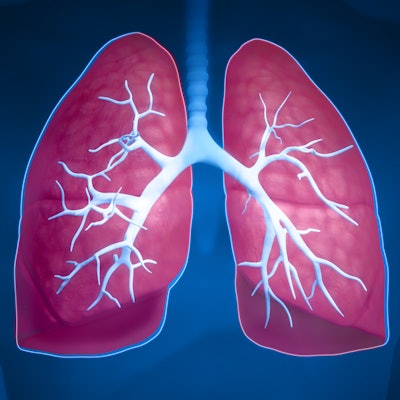
The concept of overdiagnosis has bedeviled the mammography screening debate, and it's beginning to show up in CT lung cancer screening as well. A study published online August 13 in JAMA Internal Medicine found an overdiagnosis rate of 67% in a Danish lung screening program -- much higher than rates in other programs.
In a follow-up analysis of the Danish Lung Cancer Screening Trial (DLCST), researchers from Portugal and Denmark evaluated data from more than 4,000 individuals who were eligible to undergo CT lung cancer screening. They found that the rate of overdiagnosis for lung cancer was more than threefold that of the National Lung Screening Trial (NLST) (JAMA Intern Med, August 13, 2018).
Current evidence about lung cancer overdiagnosis is marked by inconstancy -- and the high rate in this study does not necessarily suggest that this particular harm outweighs the demonstrated benefits of screening, first author Dr. Bruno Heleno, PhD, from the University of Copenhagen, told AuntMinnie.com.
"There is no single answer to whether screening is more harmful than beneficial," he said. "Qualitative studies about lung cancer screening and other forms of screening show that screening participants value the different outcomes of screening (mortality reduction, overdiagnosis, severe adverse effects of invasive testing) differently."
Variation in overdiagnosis
 Dr. Bruno Heleno, PhD, from the University of Copenhagen.
Dr. Bruno Heleno, PhD, from the University of Copenhagen.The overdiagnosis of lung cancer is a potential harm of CT screening that often proves challenging to define and communicate to patients, the authors noted. There is also uncertainty about the best way to measure the rate of overdiagnosis, and large-scale trials have reported widely different figures.
In the present study, Heleno and colleagues examined data from 4,104 current or former smokers between the ages of 50 and 70 who participated in the DLCST. Each of the participants underwent either five annual CT screening exams or no screenings at all. Their average age was 57.3 years, and 55.3% were men.
The researchers defined overdiagnosis as the detection of histologically confirmed malignant tumors through screening that would not otherwise have become clinically evident in a person's lifetime without screening. Following this definition, they discovered that clinicians had diagnosed 96 individuals with lung cancer in the screening group but only 53 individuals in the nonscreening group.
Using these data, they estimated the rate of lung cancer overdiagnosis on CT screening to be 67.2% -- considerably higher than the 18.5% rate calculated in the NLST.
In contrast, investigators leading the Italian Lung Cancer Screening Trial -- which used a similar study design and eligibility criteria as the Danish trial -- uncovered not a single instance of overdiagnosis.
Need to refine estimates
Overdiagnosis depends on the age and health status of the population, the distribution of cancer types, the screening protocol (more frequent or longer duration screening can increase overdiagnosis), and whether CT screening is compared with no screening or x-ray screening, noted Dr. Mark Ebell from the University of Georgia and Dr. Kenneth Lin from Georgetown University Medical Center in an invited commentary.
With these factors in mind, Ebell and Lin pointed to several possible explanations for the large variability in overdiagnosis among the three distinct trials, including the following:
- A higher baseline risk of lung cancer in the screened group of the DLCST
- Five rounds of screening in the DLCST compared with only three in the NLST
- The DLCST compared CT screening with no screening, whereas the NLST compared CT screening with x-ray screening
The striking disparity in overdiagnosis rates emphasizes the need "for researchers to continue to refine estimates of lung cancer overdiagnosis, allowing physicians to provide more accurate information to our patients," they wrote. "Patients can make informed choices about [CT screening] only if practitioners fully disclose all the potential harms of screening, including the risk of overdiagnosis."
One way to increase awareness of overdiagnosis may be to promote shared decision-making between physicians and patients, according to Heleno and colleagues. The use of decision aids to educate physicians and patients could potentially increase their knowledge about the topic and shape screening preferences.
However, overdiagnosis is a concept that is not easy to understand, and shared decision-making can be difficult to implement, Heleno added. Furthermore, recent research has demonstrated that the real-life application of shared decision-making for lung cancer screening may be less than effective.
Interpret with caution
"We think that the estimate drawn from the DLCST needs to be interpreted with caution and we do not advise changing current clinical practice," Heleno said. "Post-hoc analyses of baseline DLCST data suggest that the screening group may have started with a higher baseline risk of lung cancer. We think that this may bias the estimate of overdiagnosis upwards."
For now, the authors stressed the need for more data from randomized controlled trials assessing lung cancer screening, and they recommended that future trials continue to report estimates of overdiagnosis for clarification.




















